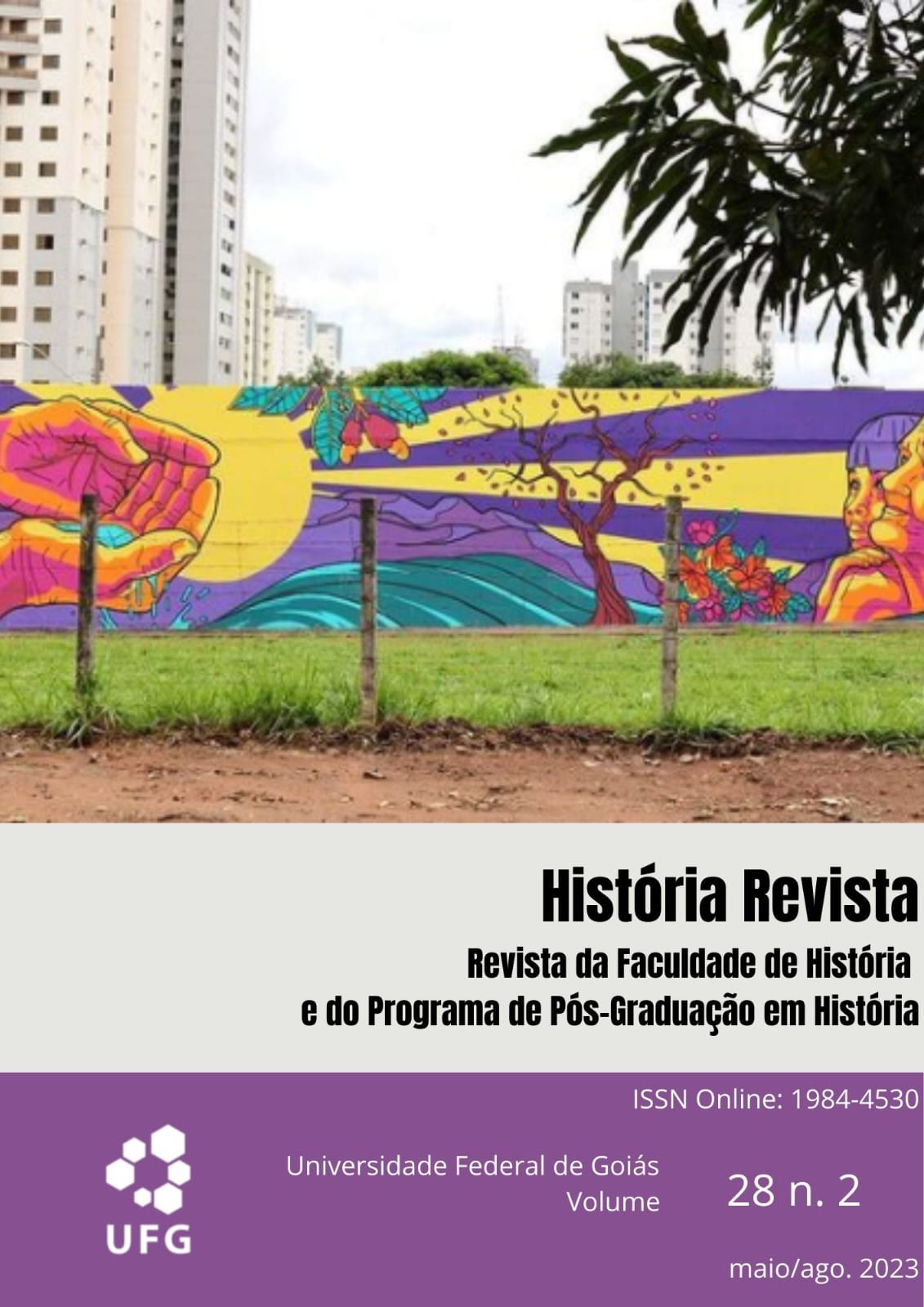Scenarisations for learning the history of Northern Roman Lusitania
DOI:
https://doi.org/10.5216/hr.v28i2.78185Keywords:
Didactics of History, Digital Pedagogical Kit, 3D ReconstructionsAbstract
Different digital technologies can foster the development of a critical conscience since they can bridge the gap between the past and the present. How often do history teachers try to get their students to formulate complex causal reasoning and to be able to understand events at not only a conjunctural but also a structural level? The possibility of developing this reasoning on a more practical level, which digital technology can make possible, could help make it easier and more correct for students to grasp history content. This paper aims to develop these ideas and present a practical example of an ongoing project that aims to prepare teaching resources to present the historical and archaeological routes of two cities in northern Roman Lusitania through 3D reconstructions, with the aim of promoting the conversion of archaeological and historiographical knowledge into teaching content that allows the history of these spaces to be truly integrated into school learning.
Downloads
References
COSTANTINO, D. et al. Strategies for 3D Modelling of Buildings from Airborne Laser Scanner and Photogrammetric Data Based on Free-Form and Model-Driven Methods: The Case Study of the Old Town Centre of Bordeaux (France). Application Sciences, v. 11, 10993, 2021. DOI: https://doi.org/10.3390/app112210993.
CORREIA, V.; RIBEIRO, J.; RUIVO, J. Conimbriga: guia das ruínas. Porto: Edições ASA, 2003.
COSTEIRA, R. et al. Plano de Investigação Plurianual de Arqueologia (PIPA) 2020-2023: Conimbriga MMXX: Avaliação do potencial científico e patrimonial do Vale Norte de Conimbriga. Coimbra: Faculdade de Letras da Universidade de Coimbra, 2020. No prelo.
DEMETRESCU, E. Virtual Reconstruction as a Scientific Tool. In: MÜNSTER, S. et al. (Eds). Digital Research and Education in Architectural Heritage. Communications in Computer and Information Science, vol 817. Berlim, Heidelberg, Dordrecht e Nova Iorque: Springer, 2018, p. 102-116. DOI: https://doi.org/10.1007/978-3-319-76992-9_7.
DEMETRESCU, E.; FERDANI, D. From Field Archaeology to Virtual Reconstruction: A Five Steps Method Using the Extended Matrix. Application Sciences, v. 11, 5206, 2021. DOI: https://doi.org/10.3390/app11115206.
DIAS-TRINDADE, S.; CARVALHO, J. R. História, tecnologias digitais e mobile learning: ensinar História na Era Digital. Coimbra: Imprensa da Universidade de Coimbra, 2019. DOI: https://doi.org/10.14195/978-989-26-1705-3.
FAZIO, L. et al. The Virtual Reconstruction of the Aesculapius and Hygeia Statues from the Sanctuary of Isis in Lilybaeum: Methods and Tools for Ancient Sculptures’ Enhancement. Application Sciences, v. 12, 3569, 2022. DOI: https://doi.org/10.3390/app12073569.
GARCÍA RUBIO, A. I. La maleta pedagógica: un proyecto educativo para el Museo Nacional de Machado de Castro. Imafronte, v. 15, p. 85-102, 2001. Disponível em: <https://revistas.um.es/imafronte/article/view/37661>. Acesso em 20 out. 2023.
HEMKER, C. et al. Virtual archaeology: making the invisible visible: Recommendations and strategies in the application of 3D digitisation and visualisation of archaeological heritage, Dresden: Archaeological Heritage Office of Saxony, 2020. Disponível em: <https://www.interreg-central.eu/Content.Node/VirtualArch-Transnational-Strategy.pdf>. Acesso em 20 out. 2023.
LIRITZIS, I.; VOLONAKIS, P.; VOSINAKIS, S. 3D Reconstruction of Cultural Heritage Sites as an Educational Approach. The Sanctuary of Delphi. Application Sciences, v. 11, 3635, 2021. DOI: https://doi.org/10.3390/app11083635.
LUIS-RUIZ, J. M. et al. Optimization of Photogrammetric Flights with UAVs for the Metric Virtualization of Archaeological Sites. Application to Juliobriga (Cantabria, Spain). Application Sciences, v. 11, 1204, 2021. DOI: https://doi.org/10.3390/app11031204.
MARTINS, G. (org.). Perfil dos alunos à saída da escolaridade obrigatória. Lisboa: Ministério da Educação, 2017.
MINISTÉRIO DA EDUCAÇÃO. Aprendizagens Essenciais – História 7º ano. Lisboa: Ministério da Educação, 2018a.
MINISTÉRIO DA EDUCAÇÃO. Aprendizagens Essenciais – História A 10º ano. Lisboa: Ministério da Educação, 2018b.
MINISTÉRIO DA EDUCAÇÃO. Aprendizagens Essenciais – História da Cultura e das Artes 10º ano. Lisboa: Ministério da Educação, 2018c.
NEUBAUER, W. et al. The discovery of the school of gladiators at Carnuntum, Austria, Antiquity, v. 88, p. 173–190, 2014.
OHTE – Observatory on History Teaching in Europe. General Report on the State of History Teaching in Europe – 2023. Bruxelas: Conselho da Europa, 2023. Disponível em: <https://rm.coe.int/ohte-general-report-full-web/1680ad80c2>. Acesso em 20 out. 2023.
PALIOU, E.; CORSI, C. “The Whole is More than the Sum of its Parts”- Geospatial Data Integration, Visualisation and Analysis at the Roman Site of Ammaia (Marvão, Portugal). In: 40TH CONFERENCE ON COMPUTER APPLICATIONS AND QUANTITATIVE METHODS IN ARCHAEOLOGY, 40TH, 2012, Southampton, Anais… Volume II. Amsterdão: Amsterdam University Press, 2013. p. 592-607. DOI: https://doi.org/10.13140/2.1.3368.1925.
PIETRONI, E.; FERDANI, D. Virtual Restoration and Virtual Reconstruction in Cultural Heritage: Terminology, Methodologies, Visual Representation Techniques and Cognitive Models. Information, v. 12, 167, 2021. DOI: https://doi.org/10.3390/info12040167.
PORTUGAL. Gabinete do Secretário de Estado da Educação. Despacho n.º 6944-A/2018 de 19 de julho de 2018. Diário da República, 2.ª série, n.º 138, p. 2.
SÁNCHEZ-SÁNCHEZ, Y. et al. 3D Modelling of Archaeoseismic Damage in the Roman Site of Baelo Claudia (Gibraltar Arc, South Spain). Application Sciences, v. 12, 5223, 2022. DOI: https://doi.org/10.3390/app12105223.
TREBELEVA, G. et al. Roman Fortress Pitiunt: 3D-Reconstruction of the Monument Based on the Materials of Archaeological Research and Geological Paleoreconstructions. Application Sciences, v. 11, 4814, 2021. DOI: https://doi.org/10.3390/app11114814.
URPI, C. Searching for Heritage Education in Archaeological Programs, Heritage & Society, v. 14, n. 1, p. 46-66, 2021. DOI: https://doi.org/10.1080/2159032X.2021.2016050.
Downloads
Published
How to Cite
Issue
Section
License
Copyright (c) 2024 História Revista

This work is licensed under a Creative Commons Attribution 4.0 International License.
Declaração de Direito Autoral
Concedo à História Revista o direito de primeira publicação da versão revisada do meu artigo, licenciado sob a Licença Creative Commons Attribution, que permite o compartilhamento do trabalho com reconhecimento da autoria e publicação inicial nesta revista.
Afirmo ainda que meu artigo não está sendo submetido a outra publicação e não foi publicado na íntegra em outro periódico, assumindo total responsabilidade por sua originalidade, podendo incidir sobre mim eventuais encargos decorrentes de reivindicação, por parte de terceiros, em relação à autoria do mesmo.



